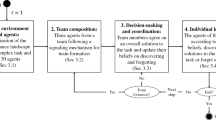Abstract
We conceptualize organizational learning as a result of the collective learning behaviour of knowledge agents in an organization. Each agent provides a range of attributes that may be required to perform organizational tasks. We devised a computational model consisting of three processes to simulate an organization's response to performing repeated tasks: (1) Expert Selection Process for selecting the winner knowledge agent or lead agent; (2) Plan Formation Process for deciding what additional attributes are needed, but not possessed by the winner expert agent, and iteratively selecting further agents with the needed attributes until the task can be accomplished by the combined attributes of the ‘coalition of agents’ so formed; and (3) Capital Modification Process for rewarding participating agents according to the success of their combined organizational performance. We observed the simulated results for different combinations of three levels of task difficulty (requiring, respectively, 5, 10 and, 15 different attributes, each at a sufficient level in the coalition or team to complete the task), and three levels of selection, during plan formation, for knowledge agent performance (the extent to which selection favours knowledge agents with much capital or large strength versus knowledge agents without much capital or large strength). The simulated organization exhibited aspects of both single loop and double loop learning, in repeatedly performing the same task, and ‘learning to perform the task’ with the smallest possible team.







Similar content being viewed by others
References
Argyris C and Schön DA (1996). Organizational Learning II. Addison-Wesley: Reading, MA.
Badaracco JL (1991). The Knowledge Link: How Firms Compete Through Strategic Alliance. Harvard Business School Press: Boston, MA.
Cohen PR and Feigenbaum EA (eds) (1982). The Handbook of Artificial Intelligence, Vol. 3. William Kaufmann: Los Altos, CA.
Cyert RM (1994). Foreword. In: Carley KM and Prietula MJ (eds). Computational Organization Theory. Lawrence Erlbaum: Hillsdale, NJ.
Davenport TH and Prusak L (1998). Working Knowledge. Harvard Business School Press: Boston, MA.
Deng PS and Tsacle E (2003). A market-based computational approach to collaborative organizational learning. J Opl Res Soc 54: 924–935.
Drucker PF (1959). Landmarks of Tomorrow. Harper: New York, NY.
Garvin D (1994). Building a learning organization. Bus Credit 96(1): 19–28.
Liu Y and Yao X (1998). A cooperative ensemble learning system. In: Proceedings of the IEEE International Joint Conference on Neural Networks. Anchorage, AK, pp 2202–2207.
March JG (1981). Decisions in organizations and theories of choice. In: Van de Ven AH and Joyce WF (eds). Perspectives on Organization Design and Behavior. John Wiley: New York, NY.
March JG and Olsen JP (eds) (1976). Ambiguity and Choice in Organizations. Universitetsforlaget: Bergen, Norway.
Scott WR (1992). Organizations: Rational, Natural, and Open Systems, 3rd edn, Prentice-Hall: Englewood Cliffs, NY.
Senge P (1990). The Fifth Discipline: The Art of Practice of Learning Organization. Currency Doubleday: New York, NY.
Simon HA (1983). Why should machines learn? In: Michalski RS, Carbonell JG and Mitchell TM (eds). Machine Learning: An Artificial Intelligence Approach. Morgan Kaufmann: Los Altos, CA.
Tsoukas H (1996). The firm as a distributed knowledge system: a constructionist approach. Strategic Management Journal 17(Winter): 11–25.
Weick KE and Roberts KH (1993). Collective mind in organizations: heedful interrelating on flight decks. Admin Sci Quart 38: 357–381.
Winter SG (1987). Knowledge and competence as strategic assets. In: Teece DJ (ed). The Competitive Challenge: Strategies for Industrial Innovation and Renewal. Ballinger: Cambridge, UK.
Winter SG (1994). Organizing for continuous improvement: evolutionary theory meets the quality revolution. In: Baum JAC and Singh J (eds). The Evolutionary Dynamics of Organizations. Oxford University Press: New York.
Acknowledgements
We express our deep appreciation for the truly insightful, helpful, and thorough reviews, which have helped refine and improve dramatically the quality and readability of this manuscript.
Author information
Authors and Affiliations
Corresponding author
Rights and permissions
About this article
Cite this article
Deng, PS., Tsacle, E. Emergent learning behaviour in a simulated organization faced with tasks requiring team effort. J Oper Res Soc 57, 603–611 (2006). https://doi.org/10.1057/palgrave.jors.2602045
Received:
Accepted:
Published:
Issue Date:
DOI: https://doi.org/10.1057/palgrave.jors.2602045




